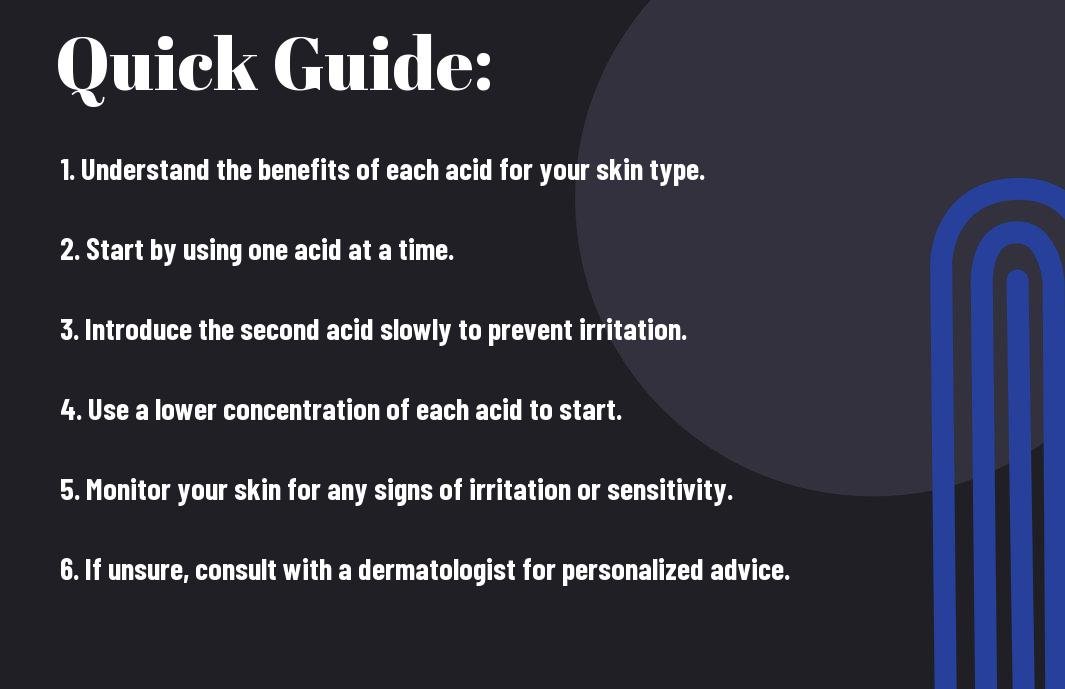Curating the perfect skincare routine can be a daunting task, especially when it comes to mixing different acids. One of the common questions I receive is whether it’s safe to use azelaic acid with salicylic acid in your skincare regimen. The short answer is, yes, you can use these two acids together, but it’s essential to proceed with caution. Both azelaic acid and salicylic acid are powerful ingredients that can work wonders for your skin, when used correctly. In this guide, I’ll walk you through the do’s and don’ts of mixing acids in your skincare routine, and provide you with the necessary information to ensure that you’re using these acids safely and effectively.
Key Takeaways:
- Azelaic acid and salicylic acid can be used together in skincare regimens: Both acids target different skin concerns, making them compatible for use in conjunction with each other.
- Consult with a dermatologist or skincare professional: It is important to seek professional advice before incorporating multiple acids into your skincare routine to avoid potential irritation or adverse reactions.
- Introduce the acids into your routine gradually: Start by using one acid at a time to assess how your skin reacts, and then gradually incorporate the other acid in a separate step to minimize potential irritation.
- Continue to monitor your skin’s response: Keep an eye on any signs of irritation, dryness, or redness, and adjust the frequency or concentration of the acids accordingly to maintain a healthy skin barrier.
- Use sunscreen daily: Both azelaic acid and salicylic acid can increase the skin’s sensitivity to the sun, so it is crucial to incorporate a broad-spectrum sunscreen into your daily skincare routine to protect your skin from UV damage.
Types of Acids in Skincare
Your skincare routine may already include acids such as alpha hydroxy acids (AHAs), beta hydroxy acids (BHAs), and azelaic acid. Each of these acids has different properties and benefits for the skin. After understanding the different types of acids, you can determine how to incorporate them into your skincare regimen.
| Acid Type | Properties |
|---|---|
| AHAs | Exfoliate the skin and improve texture |
| BHAs | Penetrate oil and exfoliate inside the pore |
| Azelaic Acid | Reduces inflammation and targets acne-causing bacteria |
Azelaic Acid
Azelaic acid is a gentle exfoliator that can improve skin texture, reduce inflammation, and target acne-causing bacteria. It is suitable for all skin types, including sensitive skin. By reducing inflammation, azelaic acid can also improve conditions such as rosacea and hyperpigmentation.
Salicylic Acid
Salicylic acid is a BHA that is known for its ability to penetrate oil and exfoliate inside the pores. It is particularly effective in treating and preventing acne, as it can unclog pores and reduce inflammation. Salicylic acid is often found in over-the-counter acne treatments and is suitable for oily and acne-prone skin.
Tips for Mixing Acids in Skincare Regimens
Obviously, mixing azelaic acid and salicylic acid in your skincare routine can be beneficial, but it’s important to do so carefully. Here are some tips to help you safely incorporate these acids into your regimen.
Start Slowly
When incorporating new acids into your skincare routine, it’s important to start slowly. This is especially true when mixing different acids. Begin by using one acid at a time to allow your skin to adjust. Once your skin has acclimated to each acid individually, you can gradually begin to introduce them into your routine.
Adjust Frequency
Once you’ve introduced both azelaic acid and salicylic acid into your routine, pay attention to how your skin responds. You may need to adjust the frequency of use for each acid based on your skin’s tolerance. Some people may be able to use both acids daily, while others may need to alternate days or even weeks.
Use Sun Protection
Both azelaic acid and salicylic acid can make your skin more sensitive to the sun. It’s essential to use SPF daily when using these acids to protect your skin from potential sun damage.
Moisturize and Hydrate
Using acids in your skincare routine can sometimes lead to dryness or irritation. Make sure to moisturize and hydrate your skin regularly to counteract any potential side effects of using acids.
- Start slowly when incorporating new acids
- Adjust the frequency of use based on your skin’s response
- Always use sun protection when using acids
- Don’t forget to moisturize and hydrate your skin
Recognizing the signs of irritation or overexfoliation is crucial when incorporating acids into your skincare regimen. If you experience prolonged redness, stinging, or burning, it may be a sign that you need to adjust your acid use. Listen to your skin and make adjustments as needed to keep it healthy and radiant.
Step-by-Step Guide for Incorporating Azelaic Acid and Salicylic Acid
While incorporating azelaic acid and salicylic acid into your skincare routine, it is important to proceed with caution and follow a step-by-step approach to prevent any adverse reactions. Here is a guide to help you effectively incorporate these two acids into your skincare regimen.
Step 1: Patch Test
Before using any new skincare product, including azelaic acid and salicylic acid, patch testing is crucial. Apply a small amount of each acid to a discreet area of your skin, such as behind the ear or on the inner forearm. Wait 24 hours to check for any redness, irritation, or allergic reactions before proceeding with full application.
Step 2: Frequency of Use
When starting out, it is advisable to introduce one acid at a time into your routine. Begin by using each acid once or twice a week, gradually increasing the frequency as your skin builds tolerance.
| Azelaic Acid | Salicylic Acid |
| Start by using a pea-sized amount of azelaic acid on clean, dry skin in the evening. Gradually increase usage to every other day or daily, depending on your skin’s tolerance. | Apply a small amount of salicylic acid to the affected areas or all over the face, depending on your skincare needs. Start with once a week and increase as tolerated. |
Step 3: Adjusting pH
It is important to consider the pH of your skincare products when using azelaic acid and salicylic acid. Azelaic acid works best at a pH of 3.5-4.5, while salicylic acid is most effective at a pH of 3-4. To ensure optimal efficacy, wait 10-15 minutes after applying azelaic acid before layering other products, and allow salicylic acid to dry fully before applying other products on top.
Step 4: Hydration and Sun Protection
Both azelaic acid and salicylic acid can be drying to the skin, so it is important to hydrate and moisturize effectively. Use a gentle, non-comedogenic moisturizer to keep your skin hydrated, and always follow up with broad-spectrum sunscreen during the day to protect your skin from potential sun damage.
Factors to Consider When Using Azelaic Acid with Salicylic Acid
Assuming that you have decided to incorporate both azelaic acid and salicylic acid into your skincare routine, there are several factors to consider in order to use them safely and effectively. Here are some key considerations:
Skin Sensitivity
When combining azelaic acid and salicylic acid, it is important to assess your skin’s sensitivity. Both acids have exfoliating properties, and using them together may be too harsh for some individuals. If you have sensitive skin, it is advisable to start with a lower concentration of each acid and gradually introduce the combination into your routine.
pH Levels
The pH levels of skincare products containing azelaic acid and salicylic acid can affect their effectiveness. Azelaic acid works best at a pH of around 4.5, while salicylic acid is most effective at a pH of 3 to 4. Using products with incompatible pH levels can reduce the efficacy of the acids. It is essential to consider the pH levels of the products you are using to ensure optimal results.
Possible Irritation
Since both azelaic acid and salicylic acid can cause dryness and irritation, combining them may increase the risk of adverse effects. If you experience any irritation, such as redness, burning, or excessive dryness, it is crucial to reassess your skincare regimen. Any signs of irritation should be addressed promptly to prevent further damage to your skin.
Consulting a Dermatologist
If you are unsure about using azelaic acid and salicylic acid together, or if you have specific skin concerns, consulting a dermatologist is highly recommended. A dermatologist can evaluate your skin type, assess any existing skin conditions, and provide personalized advice on how to incorporate these acids into your skincare regimen safely and effectively.
Pros and Cons of Using Azelaic Acid and Salicylic Acid Together
Not all skincare ingredients work well together, and it’s important to understand the potential benefits and risks of using azelaic acid and salicylic acid in the same skincare routine. Here, I’ll break down the pros and cons of using these two acids together so you can make an informed decision for your own regimen.
Benefits
When used together, azelaic acid and salicylic acid can provide a range of benefits for your skin. Azelaic acid is known for its ability to target inflammation and reduce redness, making it a great option for those with acne or rosacea. Salicylic acid, on the other hand, is a beta hydroxy acid that exfoliates the skin and unclogs pores, making it an effective treatment for acne and blackheads. When used together, these acids can complement each other to target multiple skin concerns at once.
Risks
While there are potential benefits to using azelaic acid and salicylic acid together, it’s important to be aware of the potential risks. Both of these acids can be drying and irritating to the skin, especially when used in higher concentrations. Using them together may exacerbate these effects, leading to redness, flakiness, and discomfort. It’s essential to start with lower concentrations and gradually increase the usage to minimize the risk of irritation.
Compatibility
It’s also important to consider the compatibility of azelaic acid and salicylic acid with other skincare ingredients. For example, using these acids with ingredients like retinol or vitamin C may increase the risk of irritation, so it’s important to use caution and pay attention to how your skin reacts.
Effectiveness
When using azelaic acid and salicylic acid together, it’s important to consider the overall effectiveness of the combination. While these acids can target multiple skin concerns, they may not be the most effective option for everyone. It’s essential to assess your individual skin needs and concerns to determine if this combination is the best fit for you.
Duration
Finally, it’s important to consider the duration of use when incorporating azelaic acid and salicylic acid into your skincare routine. Using these acids long-term may lead to improved skin texture and reduced acne, but it’s important to monitor your skin for any signs of overuse or irritation.

Conclusion: Can I Use Azelaic Acid with Salicylic Acid – Mixing Acids in Skincare Regimens
With these considerations in mind, it is important to remember that the combination of azelaic acid and salicylic acid can be beneficial for certain skin types and concerns. However, it is crucial to be mindful of potential irritation and to introduce these acids into your skincare routine gradually. Always patch-test new products and consult with a dermatologist if you have any underlying skin conditions or concerns. Remember to also use adequate sun protection when incorporating acids into your routine. Overall, with the right approach and careful attention to your skin’s response, using azelaic acid with salicylic acid can be an effective and safe addition to your skincare regimen.
FAQ
Q: Can I use Azelaic Acid with Salicylic Acid in my skincare regimen?
A: Yes, you can use both Azelaic Acid and Salicylic Acid in your skincare routine, but it is important to use them carefully and in the right order to avoid any adverse reactions or skin irritation.
Q: Which acid should I apply first, Azelaic Acid or Salicylic Acid?
A: It is generally recommended to apply Salicylic Acid first, as it is an exfoliating acid that helps to unclog pores and clear away dead skin cells. Once the Salicylic Acid has been absorbed, you can then apply Azelaic Acid to target hyperpigmentation and reduce inflammation.
Q: How often should I use Azelaic Acid and Salicylic Acid together?
A: It is best to start with using them together 2-3 times a week and then gradually increase the frequency as your skin builds tolerance. However, everyone’s skin is different, so it is important to listen to your skin and adjust the frequency accordingly.
Q: Are there any potential side effects of using Azelaic Acid and Salicylic Acid together?
A: Some potential side effects of using these two acids together may include dryness, peeling, redness, or irritation. It is important to introduce them slowly into your skincare routine and to always use sunscreen during the day, as both acids can make your skin more sensitive to the sun.
Q: Can I use products containing Azelaic Acid and Salicylic Acid at the same time?
A: Yes, you can use products containing both Azelaic Acid and Salicylic Acid, but it is important to check the concentration of each acid and to ensure that they are suitable for your skin type. It is also recommended to perform a patch test before using them together to check for any adverse reactions. Always consult with a dermatologist if you have any concerns.












